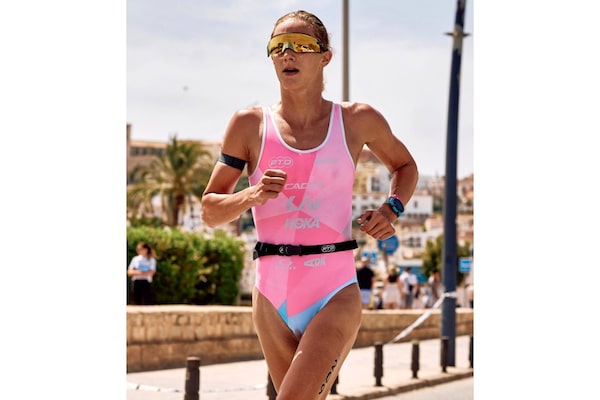
British triathlete Emma Pallant-Browne has drawn widespread praise on social media for speaking frankly about what it’s like to race while menstruating, after one of the photos posted from a triathlon in Ibiza, Spain showed she had leaked through her pale pink and blue swimsuit.Handout
One of the world’s top triathletes says she’s proud of a recent photo of her competing in a racing suit spotted with blood from her period, glad it has sparked candid conversation about the realities for female athletes.
British triathlete Emma Pallant-Browne has drawn widespread praise on social media for speaking frankly about what it’s like to race while menstruating, after a photo posted from a triathlon in Spain went viral, showing that she had leaked through her pale pink and blue swimsuit during the three-hour competition.
The photo, of Pallant-Browne racing on May 6 in the PTO European Open in Ibiza, was initially among a batch of pictures posted by the Professional Triathletes Organization on May 19. Last week, she chose to amplify it when she shared it on Instagram with her 46,000 followers – calling it “beautiful” – along with her response to a commenter who said this wasn’t “the most flattering pic” of Pallant-Browne and that it could be cropped “a bit better.”
“That’s like saying if something doesn’t look glamorous, then edit it, but there’s nothing wrong with the photo,” Pallant-Browne told The Globe in a phone interview from Johannesburg, South Africa, where the London native trains.
“If you want to be a role model, then you want to show the highs and lows, and that you’re human, and the next generation can relate to you. If you edit this out, then you’re saying I should be like a robot. A period is a normal thing, and I don’t want anyone to feel ashamed of it.”
Pallant-Browne, 33 and ranked No. 7 in the world, said she’s proud that the photo helps to normalize talk about menstruating. She said the photo also feels symbolic, because for many years earlier in her career when she was an endurance runner, she didn’t have a period. That had been a result of undereating and overtraining, a common experience for many female endurance athletes.
Because she received funding from UK Athletics, she had access to sports science and experts who insisted she’d be healthier if she got the period back. She also learned she had low bone density. She had been cutting out some food groups and training too many miles, and needed to make changes.
“It took four or so years to get my period back,” said Pallant-Browne, who is also trained as a physiotherapist. “Many people don’t realize the number of female endurance athletes that lose their period. If I hadn’t been on funding, I don’t know if I would have got the right guidance.”
Her Instagram post has since drawn more than 55,000 likes and more than 2,000 comments, everyone from professional triathletes to Olympians, Paralympians and recreational athletes, most in support. The blood stain is subtle in the photo; many said they hardly noticed it, their eyes drawn instead to her muscular build and determined expression as she ran.
Many comments were from women sharing their own stories – some vulnerable, others funny or fiercely unapologetic – about playing sports while on their periods. Many jumped in with tips about trying menstrual cups or special moisture-wicking underwear.
“I put it up to make people feel more comfortable, but I actually learned so much from them writing to me,” she said. “I felt so empowered, like this was a community.”
A few comments were from fathers with daughters, thanking her for an empowering message. She also heard from men who said “all the women I know would be horrified if they saw that photo of themselves out there.”
“I thought I should take the responsibility to tell these women who would be mortified, that they shouldn’t be mortified,” she said. “The young me, the less-healthy version of me, would be a lot more embarrassed. But I have a different view now on women’s bodies and just how amazing they are.”
Even the most well-prepared athlete can feel uneasy when her period shows up. For generations, women and girls have dubbed it as an inconvenience, the unwelcome guest, that time of the month, the visit from Aunt Flo.
Pallant-Browne prays race day doesn’t coincide with the heaviest-flow day of her period, but that day in Spain it did, and the run-bike-swim athlete rolled with it, racing to an impressive fourth-place finish.
She observes her cycle meticulously. She’s noticed her body temperature and heart rate are both often up a little on the heaviest day of her period, she typically feels foggier in the mind, her quads feel heavier than usual and her bike power falls some 10 to 20 watts. She has a darker-coloured race suit she could have worn that day, and it would have masked the blood stain she knew was likely to occur. But in especially hot racing weather – such as that day in Ibiza – Pallant-Browne opts for a lighter-coloured suit because it keeps her cooler: She’s been known to pass out or not finish races when she overheats. Pouring water over herself at aid stations cools her off and washes stains away, but she doesn’t worry much about it. She was more concerned that day with running hard, and not over-biking.
“I never want to use it as an excuse in a race – oh that was a period day,” Pallant-Browne said. “I’m really proud of that day when I remember how I was feeling in the morning, how nervous that I wasn’t going to have a good race. So to me, that’s a beautiful picture.”
Pallant-Browne did her studies in physiotherapy, and often reads research about maximizing performance, specifically for female athletes, although she says there should be more research done in the field. She has experimented with the effects of coming off caffeine in the days before her period begins, to see if it lightens the symptoms.
Society is becoming less uptight about discussing periods – a long way from the days of using a period as an instant excuse to miss gym class. In 1969, broadcaster Gordon Sinclair got in hot water with the CBC when he asked Canadian Olympic swimmer Elaine Tanner during an interview if menstruation interfered with her performance.
Today, the conversations can be more thoughtful and productive. Many women’s national and professional soccer teams around the world have announced in recent years they’ve replaced white shorts with darker colours to alleviate worries about menstrual stains.
Easing the complicated relationship between periods and exercise is a small piece of the puzzle in keeping girls playing sports longer in life. By adolescence, half of girls drop out of sport.
Pallant-Browne wishes she had this photo to share with a young athlete she encountered once who felt embarrassed about a period stain.
“Photos and experience are more powerful sometimes than just words,” she said. “And if there is a young girl to actually show this picture to I’ll say, ‘hey, this happens sometimes, and honestly, everyone is behind you,’ and you can still race, and still get a good result.”
 Rachel Brady
Rachel Brady